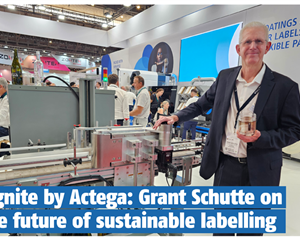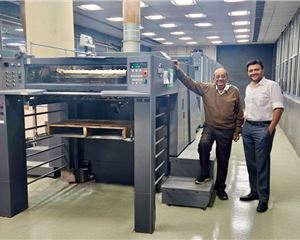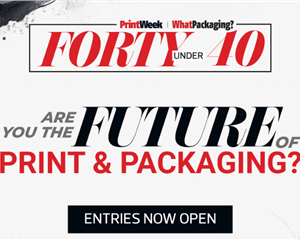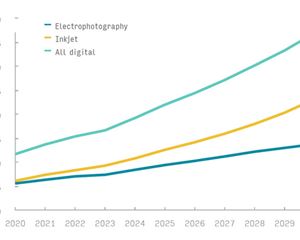PrintWeek’s Breakfast Briefing: Building factories that are green — The Noel D'Cunha Sunday Column
The closed-door confabulation on 14 October focussed on the real cost of green investments to the operational realities and circular manufacturing practices. PrintWeek sets the tone for green conversations in the industry
19 Oct 2025 | By Noel D'Cunha
At 9:09 am, as the PrintWeek Breakfast Briefing 2025 begins at The Westin Mumbai Powai Lake, sustainability takes centre stage, not as a CSR footnote but as the foundation of modern manufacturing. Sparked by Pidilite Industries’ Ashok Narayanan’s call to harness the “knowledge quotient” of Green Award winners, the briefing unites leaders from printing, converting, ink manufacturing, and supply sectors. The consensus is clear that sustainability is now the new efficiency.
From solar rooftops and rainwater harvesting to waste reduction, bio-based materials and carbon accounting, the participants share real-world examples of how green thinking has become central to production strategy. What unites them is not the size of their operations but the seriousness of their intent. As Ramu Ramanathan, editor of PrintWeek and WhatPackaging?, and moderator, notes, the industry has shifted from asking why to asking how. The discussion reveals a sector no longer content with incremental progress but intent on designing a future where sustainability is as measurable as it is meaningful.
As the conversation opens up, the first theme to take shape is the mindset shift that transforms sustainability from a slogan to a survival strategy.
“We’ve been hosting the Green Awards for three to four years, and the initiatives taken by companies towards sustainability are probably the unspoken story of the Indian printing and converting industry,” said Ramanathan.
The format was straightforward: each speaker shared one achievement, one challenge, and one plan. “We have three different industries looking at solar from totally different perspectives,” Ramanathan notes, referencing visits to factories in Maharashtra, Haryana, and Tamil Nadu.
The 99-minute discussion, described as “chaotic and informal,” aimed to foster knowledge sharing among diverse product portfolios, from labels to books.
Solar power and water wisdom
Ayush Khetan of Corrucase, a Hyderabad-based corrugated packaging firm, has set a high bar with its sustainability-first approach since 2017. “One important thing we believe in is not just providing sustainable packaging but ensuring it is manufactured sustainably,” he says. Corrucase’s captive rooftop solar plant, a pioneering move in corrugation, now meets 80% of its power needs. “We were probably the first and the only corrugated facility to install a captive rooftop solar power plant,” Khetan shares, adding that the company uses LED lights and agro-based briquettes instead of coal or wood. The result is a major drop in energy costs and a marked reduction in operational expenses.
Water scarcity in Telangana presents a significant challenge. “It is a dry state, and groundwater reserves were very low after two years,” Khetan explains. A seminar by a client in the beer industry inspires rainwater harvesting after 2020, reducing tanker dependence. “For making the corrugation board in our boilers, we require a huge amount of water to generate steam,” he says. The new harvesting system supports the process independently, cutting both costs and water use.
Future plans include expanding solar capacity by 500-kw and converting the vehicle fleet to CNG or electric. “Our customers have sustainability goals for 2030, so their end-to-end supply chain must be green,” Khetan stresses, aligning Corrucase’s operations with client ESG targets. He later emphasises efficiency as a low-cost entry into sustainability. “Focusing on efficiency does not require budgets; it sustains the business and contributes to sustainability,” he says.
A leap into solar and resilience
Vishwamdev Bhotica of SAPCO, based near Kalyan, describes a measured but effective shift into solar energy. After five years of study, SAPCO installed a rooftop solar system in 2024 that now supplies 35% of its power. “We were not sure if it would work financially, because a slightly smaller company investing heavily is risky,” Bhotica admits. Technological changes add hesitation. “Every time you study it, you think a better technology will arrive soon,” he says, “but it is never the perfect time; renewable energy has to be our priority.”
The company’s relocation to a new plant 100-km from Navi Mumbai during Covid-19 slashes sales by half and strains the workforce. “2020 to 2022 was extremely hard because investments cannot pause suddenly,” he recalls. As business stabilises, SAPCO resumes machinery upgrades and solar investments.
Bhotica also touched upon the company’s “six senses” packaging concept which adds “love” to the five senses, showcasing innovation. Future plans include more sustainable travel and expansion. “We always travel to the factory in electric cars,” Bhotica says, highlighting incremental savings that add up.
SAPCO’s commitment extends to community engagement, with a drone-shot video on LinkedIn showcasing its green campus. “We keep things under wraps until they happen,” he smiles, citing cultural caution but reaffirming steady investment in sustainability. SAPCO now stands as a regional model for green manufacturing.
.png)
Sustainability as survival
For Manu Choudhury of CDC Printers, sustainability is not a buzzword but “a way of survival.” Operating factories in Kolkata and Ahmedabad, CDC’s new facility embraces zero liquid discharge, full rainwater harvesting, and process-free plates. “We have committed to 100% use of FSC or PEFC-certified paper,” Choudhury states, dismissing cost concerns. “The cost of buying FSC paper is so fractionally less compared to the benefits. It is a crime not to use it.”
Productivity drives sustainability, boosting efficiency by 25% to 30% over peers and lowering emissions per kilogram of conversion. “Productivity is one of the biggest tools for sustainability,” he adds. Challenges remain, especially supplier data gaps for carbon footprint calculations. “We should share CO2 emissions per book with customers, like my Asics shoes that say 15-kg of CO2 were used,” he proposes.
EUDR compliance is a work in progress, and CDC looks to peers like Chennai’s Multivista for guidance. Kolkata’s unplanned growth contrasts sharply with Ahmedabad’s lean, constraint-theory-driven design, which uses AI cameras for quality checks. “Kolkata was built one square foot at a time. In Ahmedabad, we planned how the factory will look four years down the line,” he explains.
When Gurjit Singh Dhingra of Canon India raises the question of balancing business and social good, Choudhury responds firmly. “Everything we do comes back to our self-interest. Process-free plates do not cost extra. Sustainability is about being more economical, productive, and useful to the customer,” he reaffirms.
Green foundations and savings
Manish Bhatia of DIC India, an alumnus of the Cambridge Institute for Sustainable Leadership, champions the financial logic of sustainability. DIC runs 15–16 projects each year, and most pay back as quickly as standard investments. “Sustainability is great value for money,” he says, urging evaluation in the context of India’s cost of capital. “Everyone wants sustainability, but no one wants to pay for it.”
Dr Kamakshi Christopher adds that DIC’s Gujarat plant is India’s only platinum-certified green ink facility. “We are among the few organisations truly investing in a sustainability footprint in India,” she says.
Meanwhile, Gita Bajaj of Vinsak recounts practical results from their Gurgaon office. Solar panels installed in 2011 eliminate electricity bills within three years. “We have not paid an electricity bill since then,” she says. Rainwater harvesting sustains a healthy water table in a water-scarce region. “Every year we have heavy rain and then scarcity,” she observes. These early initiatives save costs and demonstrate how small offices can lead in environmental responsibility. Bajaj’s office-led strategy contrasts with factory-heavy examples but delivers the same outcome: long-term savings and conservation.
Letra Graphix: Revolutionising substrates
Nirav Shah of Letra Graphix in Ahmedabad focuses on material innovation. Working with suppliers, the company cut plastic use by 38% in two years. “We work very closely with suppliers for sustainable materials,” he says, citing fully recyclable PCR bottles and adhesives. Case studies such as Biostop’s recycled product and Kama’s globally recognised sustainable packaging reinforce Letra’s success. “We won the best sustainable award in the world with Kama,” Shah adds.
Machinery partners optimise production for low-carbon output, while Letra’s campus generates oxygen to offset emissions. “The entire campus is completely green,” Shah says. Innovations such as PET recycle liners, now used in 32% of production, and linerless labels minimise waste. “Instead of glassine liner, we moved to PET recycle, which is 100% recycled,” he explains.
ITC’s sustainability 2.0 vision
Rajesh Voruganti of ITC Packaging and Printing Business outlines the company’s Sustainability 2.0 framework, which focuses on decarbonisation, biodiversity, and water leadership. The “Well-being Out of Waste” (WOW) programme recycles paperboard and plastics, achieving a solid waste positive status. “We collect waste boards from across the country and send it to our Kovai plant for recycling,” Voruganti explains. Plastics now join the cycle for recycling or energy recovery.
The Ecobyte range focuses on fossil-fuel alternatives, recycled content, and light-weighting. “eCommute Day” bans non-electric vehicles every Wednesday. “Even the CEO’s car is not allowed unless it is electric,” he smiles, admitting that the policy prompted his own EV purchase.
At ITC’s Chennai design centre, brand managers are guided through sustainable prototypes. “We take them through solutions like a wooden barrel-themed packaging with foil stamping,” Voruganti says. Early investments in sustainability earn carbon credits and mitigate future costs. “If not for the foundation we laid, the cost to produce under new mandates would be high,” he warns. ITC’s approach as practical and scalable was appreciated.
Printmann’s ESG roadmap
Tejas Tanna of Printmann Group describes their ESG manual developed with auditing house PricewaterhouseCoopers (PwC). Annual energy audits track carbon footprints, reduced year on year by a dedicated internal team. “We have been tracking carbon footprints for almost six years,” Tanna says. Waste is sent to authorised handlers, while effluents go to Nashik Municipal Corporation’s treatment plant, from which water is repurchased for gardening.
Social initiatives include medical check-ups, anti-discrimination policies, and observances such as World Environment Day. “We believe strongly in an inclusive environment,” Tanna adds. The team even recycles Pantone batches into black ink. “We collect those batches, recycle them, and reuse them as black ink,” he explains.
Printmann’s Pakcellence venture promotes gable-top packaging as a sustainable alternative to plastic. “We are trying to create a market for sustainable options,” he says. All inks are TSE/BSE-free and REACH-compliant, despite higher costs. After acquiring a Hyderabad unit, Printmann adopts best practices across both sites. “We observed their practices for three to four months and implemented the best ones,” he says.
Tanna credits his father, Bipin Tanna, a pre-media veteran, for instilling this focus. Ramanathan recalls Bipin Tanna saying, "Look at where hot air enters and where cold air escapes," noting how his foresight for factories and early lessons in energy efficiency, despite coming from a non-print background, now define Printmann’s operations.
Multivista’s green oasis
Venu Sreedhar of Multivista Global describes their factory in Kelambakkam, set amid a 20-acre mango farm. “We give visitors mangoes in April,” he jokes, adding that clients plant trees whose growth they follow through photos. “Everyone asks, ‘How is my plant doing?’”
.png)
Sustainability starts in 2017 with EcoVadis, though early audits are discouraging. “They come back with negatives and no positives,” he recalls. Openness to improvement leads to completion of Scope 1 and 2 assessments and progress into Scope 3. Carbon emissions per book drop from 0.18% to 0.04%, and overall emissions fall from 1502 to 142 metric tonnes. “We are 100% FSC, and we have crossed 60% on EUDR,” he reports.
Multivista became India’s first printer with both EcoVadis Gold and SBTi registration and joined the Book Chain Project. “We are among the top five globally,” Sreedhar says. A Heidelberg consultant drives progress, setting monthly challenges. “He comes with investment ideas, and management hides,” Sreedhar jokes, though his advice proves transformative.
The Book Chain Project’s third-party software streamlines certification sharing and strengthens transparency. Multivista’s 50-year legacy, inaugurated by former President of India R Venkataraman, and its workforce loyalty embed sustainability deep in the company culture.
Brilliant Printers’ green transformation
Naveen Rodrigues of Brilliant Printers recounts the company’s evolution from a 55-year-old business into a seven-and-a-half-acre green facility. Solar installations since 2022 now generate 35-lakh units, meeting 30% of power needs. “We installed it in July 2022, and it contributes significantly,” Rodrigues says. Replacing CFLs with LEDs saves 45,000 units annually, while variable frequency drive compressors save another 60,000.
Rainwater harvesting raises the water table from 300-feet to about 60-feet. “That is our way of giving back to society,” he says. Plastic reduction initiatives include reusable wraps, saving eight tonnes a year, and replacing plastic tape with paper. Greenhouse gas intensity improves from 21.6% neutral in 2022 to 40.73%, with a 50% goal.
Certifications include FSC, Sedex, ISO 9001, 14001, 45001, and progress toward 50001 and 14064. Brilliant’s EcoVadis score improved from 34 to 66, targeting 75-plus. “We saw ITC receive the PrintWeek Green Award three years ago, and we were determined we would get there,” Rodrigues recalls. Fixing air leaks saves 1.5-million rupees annually. “We identified about 170 leak points; only 18 remain,” he says.
Future plans include expanding solar generation and achieving full energy and water neutrality. “We now draw five-kld, down from 25-kld, and aim for zero,” Rodrigues adds. Brilliant also specialises in thin printing for scriptures, requiring careful waste management. Italian Robo pack machines reduce plastic in palletising while raising export output.
Industry voices: Safety and value chain
Supriya Srivastava of Siegwerk highlights the importance of product safety. “It is about giving sustainable, non-carcinogenic solutions,” she says, citing toluene-free and MO-free inks. “We launched MO-free products in 2019–20, but resistance still exists,” she notes, urging faster collaboration with BIS and FSSAI to make such standards mandatory.
Ashok Narayanan of Pidilite Industries outlines his company’s sustainability strategy, which includes sourcing varnish at origin, buying in bulk flexi containers, and developing toluene-free, bio-based adhesives. “We ensure 70% of drums are recycled,” he says, though regulatory delays persist. Pidilite works with forward-thinking brands on 2030 goals. “We work with progressive partners to try new technologies,” Narayanan adds, stressing that initial costs lead to long-term benefit.
Sajith Pallippuram of Bindwel/Stelda urges value chain responsibility. “Rejections at 4–5% are criminal,” he says, advocating audits and faster production to reduce pulping. “Faster-to-market, need-based production is key,” he explains, calling for collaboration between publishers and printers. Sajith credits the print industry for facing sustainability scrutiny early due to its paper use and praises its proactive approach over superficial greenwashing.
Upendra Rajadnya of Heidelberg adds, “We provide a carbon-neutral certificate with every machine,” ensuring that even the supply side supports green goals.
The industry’s next green chapter
As the 99 minutes close, Ramu Ramanathan reflects. “What we have heard is that sustainability is not charity, it is intelligence,” he says. Shrikanth Keny and Sanjay Sawant from Kurz India; Taruna Garg from NBG Printographic; Priyank Agarwal from Superbond Adhesives were also part of the discussion.
From solar rooftops in Hyderabad to design studios in Chennai, from material and bio-based inks to rainwater harvesting in Ahmedabad and Bengaluru, every initiative shows that sustainability and efficiency are now the same language.
This breakfast briefing was a first step. The call to action is clear: to formalise this knowledge-sharing and to present a unified front that showcases the Indian print and packaging industry as a global example of sustainable, profitable, and innovative manufacturing. The green blueprint has been drawn, in the words of its own leaders, for the industry to build upon.












 See All
See All